
“Rhinoceros Gazes at the Moon (Xi Niu Wang Yue)” is the sixth routine in Health Qigong Dao Yin Yang Sheng Gong Shi Er Fa. It refers to the physiological characteristics of the rhinoceros and the peace and quiet of the moon light to persuade people to cultivate their minds and strengthen their bodies.
The Word Ocean recorded: “Rhinoceroses belong to rhinoceros, mammalia. They are large animals with thick tough skin and short necks. Some of them have one horn on its nose, some have two. Their horns are valuable medicinal materials with the functions of blood cooling, detoxicating, and heat clearing.”
A Dictionary of Detailed Tang Poetry Explanations wrote: “In mythologies, rhinoceroses have white curled marrows in their horns, connecting the horn tip and the brain like a white string, and are very sensitive. These creatures rub other buddies’ horns to show their sentiment.
Li Shangyin, the famous poet in the Tang Dynasty wrote: “Although we don’t have the wings of a colorful phoenix to fly across far distances, we have immortal rhinoceroses in our heart to communicate with each other.” In this elegant line, “the immortal rhinoceros” is a metaphor for the love and empathy between two people.
Yue(“月”) means “the moon” in the Chinese language. It is known to all that the light of the moon is reflected from the sun. The moon is especially bright on the fifteenth day of every lunar month, emitting gentle light like glittering water in the evening sky. “The move of stars and the verge of the moon” is a symbol of a silent night. Cultivating oneself and exercising in this kind of environment can bring the imagination of “the bright moonlight goes through pine trees and the spring breeze blows over the willow trees”, making people forget their worries, calm their minds and improve their health.
Also, Shuowen recorded: “The character ‘Yue’ is an incomplete circle. The moon is the essence of taiyin. This is a pictographic character. The moon’s wax and wane circulate forever. The character ‘Yue’ is incomplete. When the moon is full, it will begin to turn black. When the sun rises to its peak, it will start to set.” It is the same for our human. When you have a boom, you have a bust. Thus, ancient people warned that "Pride hurts, modesty benefits. This is a truth." (Quoted from I Ching and Chinese Characters)
Judging again from the movement structure of the “Rhinoceros Gazes at the Moon” in Dao Yin Yang Sheng Gong Shi Er Fa, we can find that it follows the overall rule of “cultivating the insufficient things with out eliminating the redundant things”. By turning the torso leftwards and rightwards, the main goals of gathering qi to the kidney, nourishing the yin and yang in the kidney, preventing diseases such as nephrosis and backache can be realized.
Then why can rotating the torso leftwards and rightwards help people gather qi to the kidney, nourish the yin and yang in the kidney, and become healthy? This question can be discussed from these two aspects:
I. Connecting the Mingmen Point and the Shenque Point can help people get rid of yin deficiency and kidney diseases.
According to TCM theories, the Mingmen Point, a point closely related to longevity, is located under the second lumbar spinous on the back. (This point belongs to the kidney and is on the right of the viscus.) According to Nanjing Sanshijiunan: “The Mingmen Point is the place where mind and the source qi rests. Men store their essence here and women use the point to nourish their abdomens. The qi here is connected to the kidneys (the Mingmen point serves as the moving qi between the two kidneys), and the ‘moving qi’ is the origin of the fresh qi, the root of the viscera and the twelve meridians, the gate of breath, and the origin of the triple energizers.”
Also, there is another point which can bring longevity on the Conception Vessel in the front of the body. It is called Shenque Point. According to Huiyuanzhenjiuxue: In Chinese language, Shenque indicates the place where immortals live. The upper part belongs to the heaven, the lower part belongs to the earth, the middle part belongs to the human, on the two sides there are the Huangyu Points, the qi points of the kidney meridian of foot-shaoyin, above it there are the Shuifen Point and the Xiawan Point, below it there are the Yinjiao Point, the Qihai Point, and the Guanyuan Point. The navel is in the center, acting as the entering gate(Que) and the spirit(Shen) connecting the innate foundation. Zhongyizhenjiuxue also wrote: “The immortal living in the Shenque is actually the mind and the vitality. In Chinese language, Que means the gate of the emperor's palace. Here it indicates the living place of vitality.” “Moxibustion with ginger or salt can treat diseases such as kidney diseases, stroke, prostration, fatigue, rectocele, and infertility.”
It is proved by practice that when doing the routine of “Ji Chang Shoots a Louse”, twisting and turning the body can effectively promote the qi from the Governor Vessel in the Mingmen Point and the qi from the Conception Vessel in the Shenque Point, combine the back and front, the yin and yang together, realizing the effect of nourishing the yin and promoting the yang in the kidney, gaining more power and strengthening the body.
(By Zhang Guangde and Si Chaoquan)

